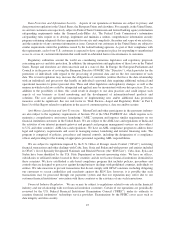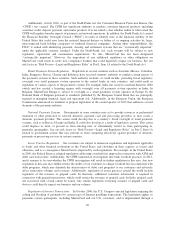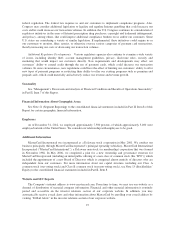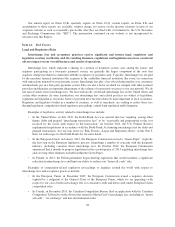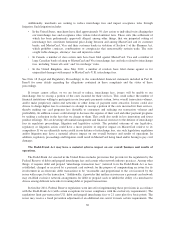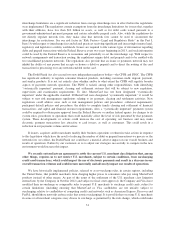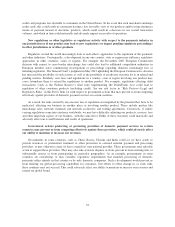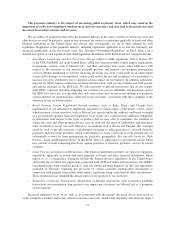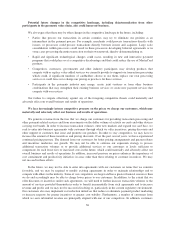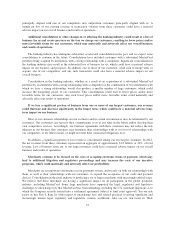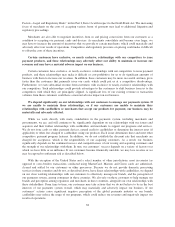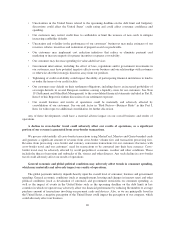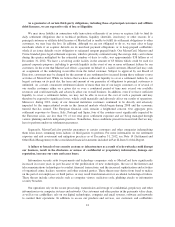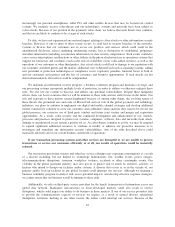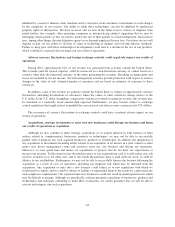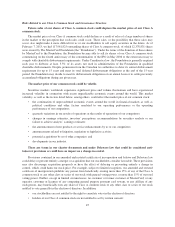MasterCard 2012 Annual Report Download - page 39
Download and view the complete annual report
Please find page 39 of the 2012 MasterCard annual report below. You can navigate through the pages in the report by either clicking on the pages listed below, or by using the keyword search tool below to find specific information within the annual report.Potential changes in the tax laws applicable to us could materially increase our tax payments.
Potential changes in existing tax laws, such as recent proposals for fundamental tax reform in the United
States, including the treatment of earnings of controlled foreign corporations, may impact our effective tax rate
and tax payments. This could adversely impact our results of operations. See also Note 17 (Income Tax) to the
consolidated financial statements included in Part II, Item 8.
Business Risks
Substantial and increasingly intense competition worldwide in the global payments industry may
materially and adversely affect our overall business and results of operations.
The global payments industry is highly competitive. Our payment programs compete against all forms of
payment, including paper-based transactions (principally cash and checks); card-based or other electronic
payment programs or systems, including credit, charge, debit, prepaid, private-label and other types of general
purpose and limited use programs; contactless, mobile and web-based payment platforms; and other electronic
transactions such as wire transfers and Automated Clearing House payments. Within the global general purpose
payments industry, we face substantial and increasingly intense competition worldwide from systems such as
Visa, American Express, Discover, UnionPay, JCB and PayPal among others. Visa has greater volume than we
do, and has greater scale and market share, as well as strong brand recognition, which may provide significant
competitive advantages. Moreover, some of our traditional competitors, as well as alternative payment service
providers, may have substantially greater financial and other resources than we have, may offer a wider range of
programs and services than we offer or may use more effective advertising and marketing strategies to achieve
broader brand recognition or merchant acceptance than we have. Our ability to compete may also be affected by
the outcomes of litigation, competition-related regulatory proceedings, central bank activity and legislative
activity.
Certain of our competitors, including American Express, Discover, private-label card networks and certain
alternative payments systems, operate end-to-end payments systems with direct connections to both merchants
and consumers. These competitors seek to derive competitive advantages from their business models. For
example, operators of end-to-end payments systems tend to have greater control over consumer and merchant
customer service than operators of four-party payments systems such as ours, in which we must rely on our
issuing and acquiring financial institution customers. In addition, even when they operate programs that utilize a
four-party system, these competitors have not attracted the same level of regulatory or legislative scrutiny of their
pricing and business practices as have operators of four-party payments systems such as ours. If we continue to
attract more regulatory scrutiny than these competitors because we operate a four-party system, or we are
regulated because of the system we operate in a way in which our competitors are not, we could lose business to
these competitors. Certain competitors may also hold competitive advantages as a result of their organizational
structures. See “Business-Competition” in Part I, Item 1.
If we are not able to differentiate ourselves from our competitors, drive value for our customers and/or
effectively align our resources with our goals and objectives, we may not be able to compete effectively against
these threats. Our competitors may also more effectively introduce their own innovative programs and services
that adversely impact our growth. Our customers can also develop their own competitive services. We also
compete against new entrants that have developed alternative payments systems, e-commerce payments systems
and payments systems for mobile devices, as well as physical store locations. A number of these new entrants
rely principally on the Internet to support their services and may enjoy lower costs than we do, which could put
us at a competitive disadvantage. Our failure to compete effectively against any of the foregoing competitive
threats could materially and adversely affect our overall business and results of operations.
35


